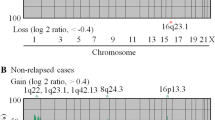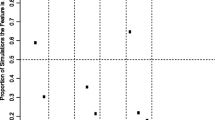Abstract
Although a simple linear progression model for breast cancer has already been proposed, its validity still remains controversial. Especially, the genetic and molecular features of breast cancer at different stages during the development and progression, as well as their relationship, have rarely been studied under the same experimental conditions simultaneously. According to these limitations in this research area, the current study applied comparative genomic hybridization technique to investigate genomic changes in 15 cases of breast atypical ductal hyperplasia (ADH), 15 cases of ductal carcinomas in situ (DCIS), and 15 cases of invasive ductal carcinomas (IDC) and the relationship among the genetic changes. Thirty commonly altered regions that were identified included known (gains of 1q,8q, 17q,20q,Xq and losses of 8p,13q,16q,17p,22q) and several uncharacterized (gains of 2q,5p, 10p,12q,16p,18q, etc. and losses of 11p13-pter,11q,14q,Xp, etc). The overall frequency of copy number losses was higher in IDC than that in DCIS (P = 0.013). ADH showed more frequent gain of 17q than that in IDC (P = 0.007), and IDC exhibited a higher frequency for the loss of 22q than that in ADH (P = 0.018). On one hand, several common genomic changes shared by ADH, DCIS, and IDC make a linear relationship for these three lesions possible. On the other hand, the heterogeneity has also showed clonal diversification and different pathways of breast cancer progression. The regions of chromosomal copy number alterations may bring new insights into the strategy for tumor progression blocking and the discovery of new potential targets for breast cancer treatment.



Similar content being viewed by others
References
Niu Y (2006) Pathology diagnostics of breast tumors. Science and Technology Publishing House, Tianjin
Kuukasjärvi T, Tanner M, Pennanen S, Karhu R, Kallioniemi OP, Isola J (1997) Genetic changes in intraductal breast cancer detected by comparative genomic hybridization. Am J Pathol 150:1465–1471
Hwang ES, DeVries S, Chew KL, Moore DH 2nd, Kerlikowske K, Thor A, Ljung BM, Waldman FM (2004) Patterns of chromosomal alterations in breast ductal carcinoma in situ. Clin Cancer Res 10:5160–5167
Fujii H, Szumel R, Marsh C, Zhou W, Gabrielson E (1996) Genetic progression, histological grade, and allelic loss in ductal carcinoma in situ of the breast. Cancer Res 56:5260–5265
Radford DM, Phillips NJ, Fair KL, Ritter JH, Holt M, Donis-Keller H (1995) Allelic loss and the progression of breast cancer. Cancer Res 55:5180–5183
Gong G, DeVries S, Chew KL, Cha I, Ljung BM, Waldman FM (2001) Genetic changes in paired atypical and usual ductal hyperplasia of the breast by comparative genomic hybridization. Clin Cancer Res 7:2410–2414
Lakhani SR, Collins N, Stratton MR, Sloane JP (1995) Atypical ductal hyperplasia of the breast: clonal proliferation with loss of heterozygosity on chromosomes 16q and 17p. J Clin Pathol 48:611–615
Lakhani SR, Slack DN, Hamoudi RA, Collins N, Stratton MR, Sloane JP (1996) Detection of allelic imbalance indicates that a proportion of mammary hyperplasia of usual type are clonal, neoplastic proliferations. Lab Invest 74:129–135
Hermsen MA, Meijer GA, Baak JP, Joenje H, Walboomers JJ (1996) Comparative genomic hybridization: a new tool in cancer pathology. Hum Pathol 27:342–349
Ostroverkhova NV, Nazarenko SA, Cheremnykh AD (2002) Comparative genomic hybridization as a new method for detection of genomic imbalance. Genetika 38:149–160
Levy B, Hischhorn K (2002) Characterization of constitutional chromosome abnormality by comparative genomic hybridization. Methods Mol Biol 204:121–132
Korinth D, Donhuijsen K, Bockmühl U, Petersen I (2004) PHOTOPROBE biotin: an alternative method for labeling archival DNA for comparative genomic hybridization. Cell Oncol 26:329–334
Reis-Filho JS, Simpson PT, Gale T, Lakhani SR (2005) The molecular genetics of breast cancer: the contribution of comparative genomic hybridization. Pathol Res Pract 201:713–725
Lv S, Niu Y, Wei L, Liu Q, Wang X, Chen Y (2008) Chromosomal aberrations and genetic relations in benign, borderline and malignant phyllodes tumors of the breast: a comparative genomic hybridization study. Breast Cancer Res Treat (Epub ahead of print). doi:10.1007/s10549-007-9876-1
Toumpanakis CG, Caplin ME (2008) Molecular genetics of gastroenteropancreatic neuroendocrine tumors. Am J Gastroenterol 103:729–732
Tavassoli FA, Devilee P (2003) The WHO classification of tumors of the breast and female genital organs. IARC, Lyon
Rennstam K, Ahlstedt-Soini M, Baldetorp B, Bendahl PO, Borg A, Karhu R, Tanner M, Tirkkonen M, Isola J (2003) Patterns of chromosomal imbalances defines subgroups of breast cancer with distinct clinical features and prognosis. A study of 305 tumors by comparative genomic hybridization. Cancer Res 63:8861–8868
Bednarek AK, Laflin KJ, Daniel RL, Liao Q, Hawkins KA, Aldaz CM (2000) WWOX, a novel WW domain-containing protein mapping to human chromosome 16q23.3–24.1, a region frequently affected in breast cancer. Cancer Res 60:2140–2145
Buerger H, Mommers EC, Littmann R, Diallo R, Brinkschmidt C, Poremba C, Dockhorn-Dworniczak B, van Diest PJ, Böcker W (2000) Correlation of morphologic and cytogenetic parameters of genetic instability with chromosomal alterations in in situ carcinomas of the breast. Am J Clin Pathol 114:854–859
Yaremko ML, Recant WM, Westbrook CA (1995) Loss of heterozygosity from the short arm of chromosome 8 is an early event in breast cancers. Genes Chromosomes Cancer 13:186–191
Ni CY, Murphy MP, Golde TE, Carpenter G (2001) gamma-Secretase cleavage and nuclear localization of ErbB-4 receptor tyrosine kinase. Science 294:2179–2181
Tanner MM, Tirkkonen M, Kallioniemi A, Holli K, Collins C, Kowbel D, Gray JW, Kallioniemi OP, Isola J (1995) Amplification of chromosomal regions 20q13 in invasive breast cancer: prognostic in placations. Clin Cancer Res 1:1455–1461
Savelieva E, Belair CD, Newton MA, DeVries S, Gray JW, Waldman F, Reznikoff CA (1997) 20q gain associates with immortalization: 20q13.2 amplification correlates with genome instability in human papillomavirus 16E7 transformed human uroepithelial cells. Oncogene 14:551–560
Cuthill S, Agarwal P, Sarkar S, Savelieva E, Reznikoff CA (1999) Dominant genetic alterations in immortalization: role for 20q gain. Genes Chromosomes Cancer 26:304–311
Collins C, Volik S, Kowbel D, Ginzinger D, Ylstra B, Cloutier T, Hawkins T, Predki P, Martin C, Wernick M, Kuo WL, Alberts A, Gray JW (2001) Comprehensive genome sequence analysis of a breast cancer amplicon. Genome Res 11:1034–1042
Loo LW, Grove DI, Williams EM, Neal CL, Cousens LA, Schubert EL, Holcomb IN, Massa HF, Glogovac J, Li CI, Malone KE, Daling JR, Delrow JJ, Trask BJ, Hsu L, Porter PL (2004) Array comparative genomic hybridization analysis of genomic alterations in breast cancer subtypes. Cancer Res 64:8541–8549
Isola JJ, Kallioniemi OP, Chu LW, Fuqua SA, Hilsenbeck SG, Osborne CK, Waldman FM (1995) Genetic aberrations detected by comparative genomic hybridization predict outcome in node-negative breast cancer. Am J Pathol 147:905–911
Jacobs JJ, Keblusek P, Robanus-Maandag E, Kristel P, Lingbeek M, Nederlof PM, van Welsem T, van de Vijver MJ, Koh EY, Daley GQ, van Lohuizen M (2000) Senescence bypass screen identifies TBX2, which represses Cdkn2a (p19(ARF)) and is amplified in a subset of human breast cancers. Nat Genet 26:291–299
Werner M, Mattis A, Aubele M, Cummings M, Zitzelsberger H, Hutzler P, Höfler H (1999) 20q13.2 amplification in intraductal hyperplasia adjacent to in situ and invasive ductal carcinoma of the breast. Virchows Arch 435:469–472
Mao B, Wu W, Davidson G, Marhold J, Li M, Mechler BM, Delius H, Hoppe D, Stannek P, Walter C, Glinka A, Niehrs C (2002) Kremen proteins are Dickkopf receptors that regulate Wnt/beta-catenin signaling. Nature 417:664–667
Acknowledgements
The authors gratefully acknowledge Chinese National Human Genome Center for the completion of the project. This research project was supported by a grant from the National Natural Science Foundation of China (No: 30471967).
Author information
Authors and Affiliations
Corresponding author
Electronic supplementary material
Below is the link to the electronic supplementary material.
ESM
(DOC 436 KB)
Rights and permissions
About this article
Cite this article
Gao, Y., Niu, Y., Wang, X. et al. Genetic changes at specific stages of breast cancer progression detected by comparative genomic hybridization. J Mol Med 87, 145–152 (2009). https://doi.org/10.1007/s00109-008-0408-1
Received:
Revised:
Accepted:
Published:
Issue Date:
DOI: https://doi.org/10.1007/s00109-008-0408-1




